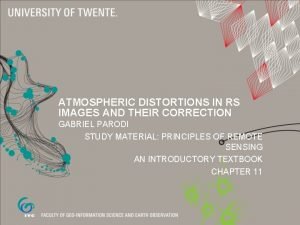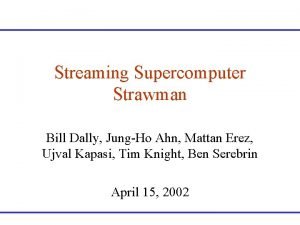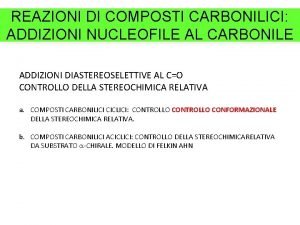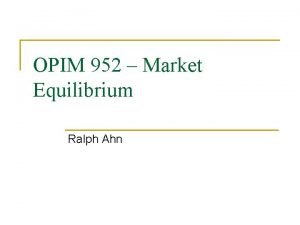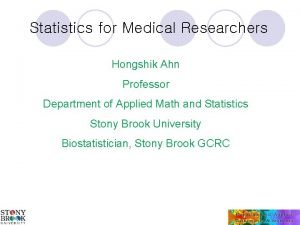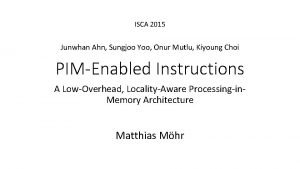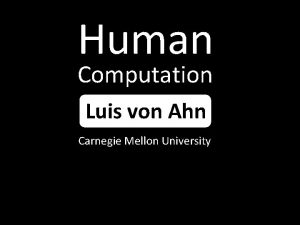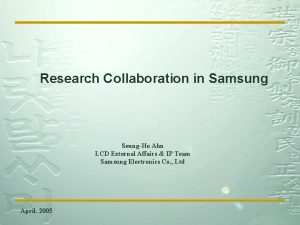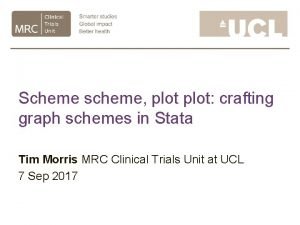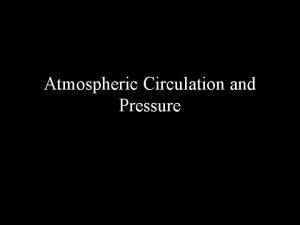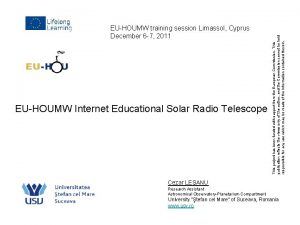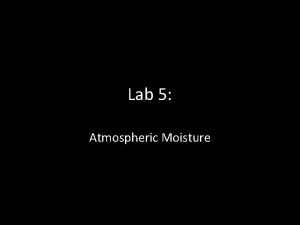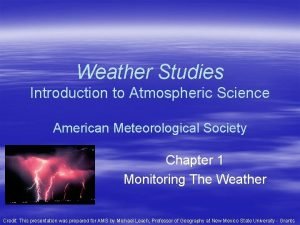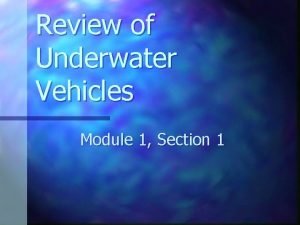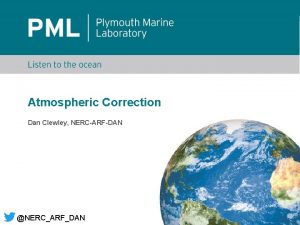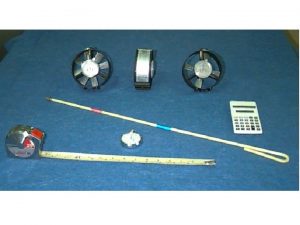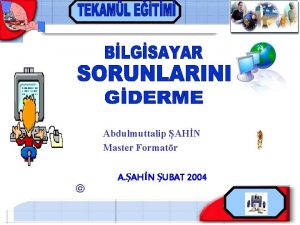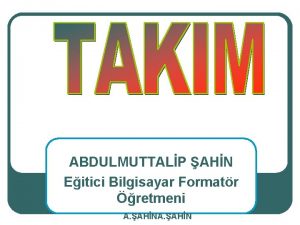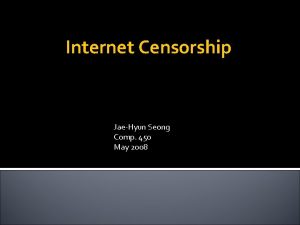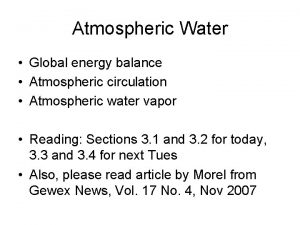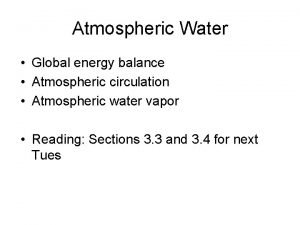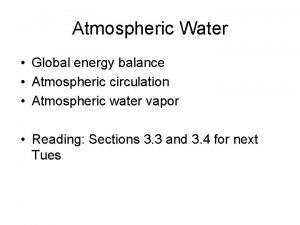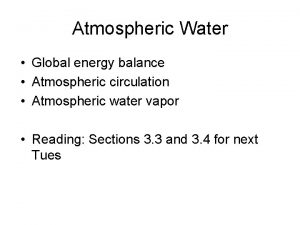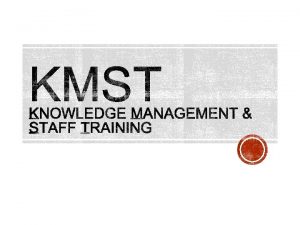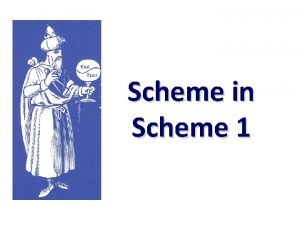Updated GOCI atmospheric correction scheme JaeHyun Ahn Youngje






















- Slides: 22

Updated GOCI atmospheric correction scheme Jae-Hyun Ahn Youngje Park Wonkook Kim Boram Lee Korea Ocean Satellite Center (KOSC) Korea Institute of Ocean Science & Technology (KIOST) NASA GEO-CAPE community workshop 01/Sep. /2015

Atmospheric correction implemented in GDPS v. 1. 2 Differences compared to Sea. Wi. FS & MODIS standard method (Ahn et al. , 2012) 1) Aerosol models Ø Using 3 -aerosol models: M 99, M 50, C 50 2) NIR correction scheme for turbid water AC > Using relationship between ρwn(660 nm), ρwn(745 nm) and ρwn(865 nm) where 3) Many missing parts… Ø Near real-time meteorological data (wind field, O 3, air pressure) Ø BRDF Ø Vicarious calibration Ø Sun-glint Ø Flag

Atmospheric correction implemented in GDPS v. 1. 3 Updated features since GDPS v. 1. 2 (Ahn et al. 2015) 1) Vicarious calibration is applied Ø Almost identical to Franz et al. (2007) 2) BRDF correction is implemented 1) Air-sea interface Ø Upward: Fresnel Eq. with assumption “wind speed = 0” Ø Downward: Wang (2006) model with adjusted coefficients for spectral responses of GOCI bands 2) f/Q correction Ø LUT is generated by Morel (based on biogenic optical properties) 3) Support 32 bit flags for quality analysis 4) Turbid water NIR correction model is updated jn={-0. 00148, 0. 4865, -22. 93, 615. 8, -6760. 0 , 30210. 0} kn={0. 5012, 4. 0878} v. 1. 2 v. 1. 3

Atmospheric correction implemented in GDPS v. 1. 3. 1 Updated features since GDPS v. 1. 3 1) Sun-glint correction is implemented Ø 2) Wind direction dependent Cox & Munk model White-cap correction is modified Ø GDPS v. 1. 3 • • Gordon & Wang (1994), Frouin et al. (1996) Give weight factor, 0. 4 Ø GDPS v. 1. 3. 1 • • Stramska & Petelski (2003), Frouin et al. (1996) Weight factor is removed 3) Water vapor correction is implemented 4) Turbid water NIR correction model is adjusted 5) Rayleigh correction is enhanced Ø LUT resolution is increased 6) Vicarious calibration gains are adjusted after AC updates

Atmospheric correction updates to GDPS v. 1. 3. 1 (since v. 1. 3) Water vapor correction Ø Revised Vermeulen’s simulation with extended water vapor concentration and total air mass - Total airmass: 2~10 - Water vapor: 1~9 (g/cm 2) Ø Statistical data were derived by radiative transfer model (6 sv) - Atmospheric composition and vertical profile were derived from US 62 model Ø 2 nd order polynomial relationship between ln(airmass*water_vapor) and ln{-ln(Twv)}

Atmospheric correction updates to GDPS v. 1. 3. 1 (since v. 1. 3) Water vapor correction (impact on Rrs) Rrs. Diff (%) = { (Rrscorr - Rrsuncorr) / Rrscorr }*100 Water vapor concentration (g/cm 2) (2011/04/05 03: 16) Rrs. Diff (443 nm) (2011/04/05 03: 16) Rrs. Diff (490 nm) (2011/04/05 03: 16) 100 % 0% Rrs. Diff (555 nm) (2011/04/05 03: 16) Rrs. Diff (660 nm) (2011/04/05 03: 16) Rrs. Diff (680 nm) (2011/04/05 03: 16) -100 %

Atmospheric correction updates to GDPS v. 1. 3. 1 (since v. 1. 3) Water vapor correction (impact on Chl-a) Chl-a. Diff (%) = { (Chl-acorr - Chl-auncorr) / Chl-acorr }*100 Chl-auncorr (2011/04/05 03: 16) 0. 0 Chl-acorr 5. 0 unit: mg/m 3 (2011/04/05 03: 16) 0. 0 Chl-a. Diff (2011/04/05 03: 16) 5. 0 unit: mg/m 3 -100 % 0% 100 % 200 %

Atmospheric correction updates to GDPS v. 1. 3. 1 (since v. 1. 3) Vicarious calibration gain GDPS v. 1. 3. 1 GDPS v. 1. 3 (Ahn et al. , 2015) modified MSL-12 (Wang et al. , 2013) modified MSL-12 (Wang et al. , 2012) 412 443 490 555 660 680 745 865 0. 99849 0. 98135 0. 96605 0. 97344 0. 99491 0. 99208 0. 98031 1. 0105 0. 9891 0. 9611 0. 9186 0. 9567 0. 9659 0. 9613 1. 0 0. 9862 0. 9753 0. 9473 0. 9149 0. 9245 0. 9223 0. 943 1. 0 0. 9857 0. 9749 0. 9484 0. 9179 0. 9299 0. 9183 0. 9502 1. 0

Atmospheric correction updates to GDPS v. 1. 3. 1 (since v. 1. 3) Turbid water NIR correction model Ø Estimation of water reflectance in NIR bands jn={-1. 009046 E-03, 5. 158649 E-01, -2. 181632 E+01, 5. 509967 E+02, -5. 899103 E+03, 2. 726468 E+04} kn={0. 468, 3. 8204}

Atmospheric correction updates to GDPS v. 1. 3. 1 Validation (in situ measurements)

Atmospheric correction updates to GDPS v. 1. 3. 1 Validation (AERONET_OC)

Summary & discussion 1. Summary of GOCI AC Ø GOCI AC has developed based on NASA standard AC method Ø Major differences • Turbid water NIR correction • Using 3 -Aerosol models • Estimation of Rayleigh reflectance 2. Discussion Ø Remaining issues • High SZA issue: Rrs(blue) is consistently lower for high SZA than normal angles • BRDF correction based on case-1 waters • 745 nm calibration issue Ø AC update plans • • • Vicarious gain update BRDF correction model update Aerosol model update Build NIR correction model based on in situ data A new aerosol model selection scheme using the multiple-scattering epsilon – The scheme is much simpler & faster – The scheme produces less error with assumption that aerosol model is correct

Thank you Jae-Hyun Ahn brtnt@kiost. ac Youngje Park youngjepark@kiost. ac. kr

Appendix

A new ρa(λ)+ρra(λ) estimation using multiple-scattering ε

A new ρa(λ)+ρra(λ) estimation using multiple-scattering ε • A new approach Relationship example at θs: 60° , θv: 40°, ϕ: 40°

A new ρa(λ)+ρra(λ) estimation using multiple-scattering ε • A new approach Get mixture ratio of 2 -selected aerosol models LUT (θs , θv , ϕs-v) Solve quadric equation w. M 1 : weighting factor for aerosol model 1 (unknown value to solve) an. M 1& an. M 2 : relationship coefficients (stored in LUT), function of geometric angles and aerosol models

A new ρa(λ)+ρra(λ) estimation using multiple-scattering ε • A new approach Get relationship between ρa(λ 1)+ρra(λ 1) and ρa(λ 2)+ρra(λ 2) from the LUT

A new ρa(λ)+ρra(λ) estimation using multiple-scattering ε • A new approach Optical thickness & transmittance estimation

A new ρa(λ)+ρra(λ) estimation using multiple-scattering ε • Comparison of each Algorithm (NASA standard) (1) (2) (3 -1) (4 -1) (5) (6) (7)

A new ρa(λ)+ρra(λ) estimation using multiple-scattering ε • Comparison of each Algorithm (MERIS, OCTS) OCTS MERIS

A new ρa(λ)+ρra(λ) estimation using multiple-scattering ε • A new approach (1) (2) (3) (4)
 Bitnicy subkultura
Bitnicy subkultura Atmospheric distortion correction
Atmospheric distortion correction During _______ branching, only car is updated with adr
During _______ branching, only car is updated with adr Star interview
Star interview Designing games with a purpose
Designing games with a purpose Jungho ahn
Jungho ahn Felkin ahn
Felkin ahn Ralph ahn
Ralph ahn Hongshik ahn
Hongshik ahn Junwhan ahn
Junwhan ahn Two-player
Two-player Seungho ahn samsung
Seungho ahn samsung 3 domain scheme and 5 kingdom scheme
3 domain scheme and 5 kingdom scheme Stata graph schemes download
Stata graph schemes download Ponzi scheme vs pyramid scheme
Ponzi scheme vs pyramid scheme Circulates air between 60-90 latitudes
Circulates air between 60-90 latitudes Atmospheric opacity
Atmospheric opacity Atmospheric physics lecture notes
Atmospheric physics lecture notes Lab 5 atmospheric moisture
Lab 5 atmospheric moisture Global warming
Global warming Weather studies introduction to atmospheric science
Weather studies introduction to atmospheric science Atmospheric diving suit
Atmospheric diving suit Hadley cells
Hadley cells

